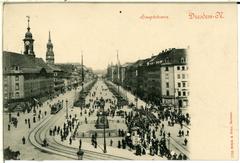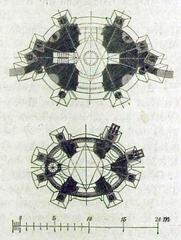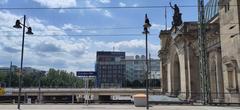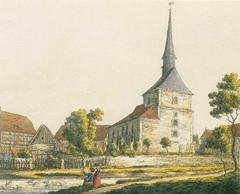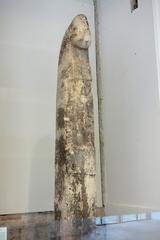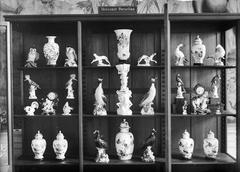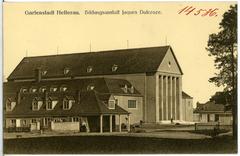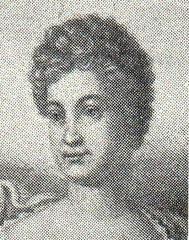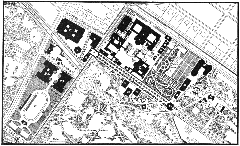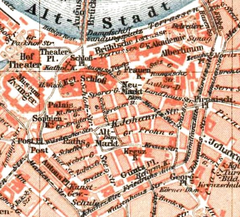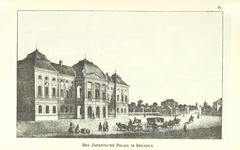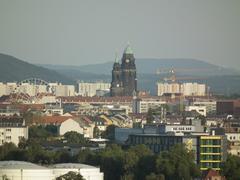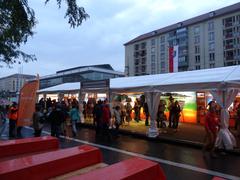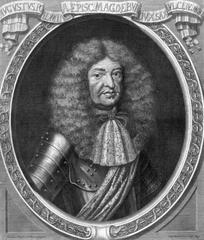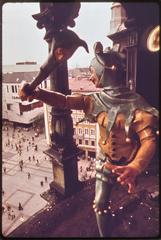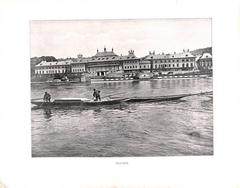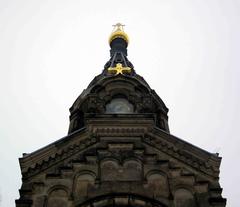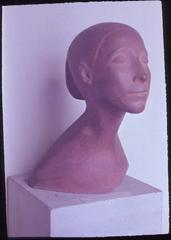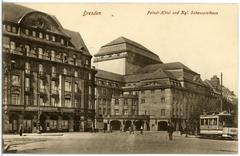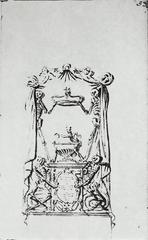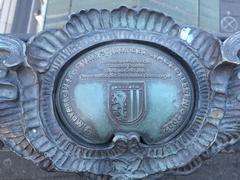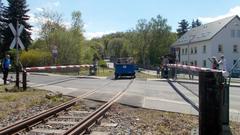Heidefriedhof Dresden: Visiting Hours, Tickets, and Historical Significance
Date: 04/07/2025
Introduction
Heidefriedhof Dresden stands as one of the city’s most significant and evocative sites, uniquely blending natural woodland tranquility with memorials that commemorate the tragedies and resilience of Dresden’s 20th-century history. Established in the late 1920s and officially opened in 1936, Heidefriedhof was conceived as a “Waldfriedhof” (woodland cemetery), representing a shift toward egalitarian and nature-integrated burial practices. Today, it serves not only as a final resting place but also as a vital center for remembrance, education, and reflection (Heidefriedhof Dresden Flyer, 2025).
This comprehensive guide details everything you need to know about visiting Heidefriedhof Dresden: its historical evolution, layout, notable memorials, visiting hours, ticketing, accessibility, and practical travel tips. Whether you are a history enthusiast, cultural traveler, or seeking a peaceful environment, Heidefriedhof offers a meaningful and educational experience.
Table of Contents
- Introduction
- Historical Background and Development
- Wartime Expansion and World War II Significance
- Layout and Spatial Organization
- Entrances, Pathways, and Navigation
- Burial Fields and Vegetation
- Memorials and Notable Features
- Visiting Hours, Tickets, and Practical Information
- Guided Tours and Events
- Nearby Attractions and Travel Tips
- Visitor Facilities and Accessibility
- Essential Visitor Tips
- Sustainability and Environmental Practices
- Frequently Asked Questions (FAQ)
- Conclusion and Further Resources
Historical Background and Development
Origins and Early Development (1927–1939)
Heidefriedhof was established in response to Dresden’s growing population and the need for a modern, large-scale municipal cemetery. Planning began in 1927, with a focus on integrating the cemetery into the natural landscape of the “Junge Heide” (Young Heath) forest. This approach emphasized simplicity, ecological cycles, and the equality of all people in death, with uniformly laid-out graves and a landscape that evokes natural renewal (Heidefriedhof Dresden Flyer, p.1). Operations commenced in 1936, and the cemetery quickly became Dresden’s principal burial site.
Wartime Expansion and World War II Significance (1939–1945)
The rise of the National Socialist regime and the onset of World War II deeply impacted Heidefriedhof. Anticipating wartime casualties, a dedicated “Ehrenhain” (grove of honor) was planned in 1939. During the devastating Allied bombings of Dresden in February 1945, Heidefriedhof became the primary burial ground for thousands of victims, with mass graves and memorial groves established to commemorate the loss (abolishcommemoration.org). The cemetery’s role as a site of collective memory and mourning continues to shape its identity today.
Layout and Spatial Organization
General Plan
Heidefriedhof covers approximately 30 hectares within the larger 400-hectare Junge Heide forest. The design features a rectilinear grid of long, straight axes—both longitudinal and transverse—derived from forest clearings. This grid divides the cemetery into rectangular fields and creates clear sightlines, with the main axis running 400 meters from the entrance to the central memorial grove (Ehrenhain) (TU Dresden Poster).
A dense belt of pine, beech, birch, and oak trees surrounds the grounds, creating a tranquil, acoustically insulated environment. The woodland character is integral to the cemetery’s serene and contemplative atmosphere.
Entrances, Pathways, and Navigation
The main entrance is located at Moritzburger Landstraße, with secondary entrances also available. Upon entry, the principal axis guides visitors past the ceremonial hall towards the memorial complexes. The internal path network is strictly rectilinear, aiding orientation and navigation. Alphanumeric codes mark different burial fields, and both on-site and downloadable maps are available (Dresden Elbland).
Burial Fields and Vegetation
Each burial field is designated for specific types of interment, including earth and urn graves, and some special fields are set aside for children, miscarried infants, and distinct religious communities. Mature woodland plantings, undergrowth, and tall shrubs create a sense of seclusion, foster biodiversity, and enhance the cemetery’s ecological value (TU Dresden Poster).
Memorials and Notable Features
Ehrenhain (Memorial Grove)
At the heart of Heidefriedhof is the Ehrenhain, a central memorial grove inaugurated in 1965 and now under historical protection. The Ehrenhain consists of a circular memorial complex honoring the victims of fascism, Nazi persecution, and the destruction of Dresden. It serves as a focal point for annual commemorations and reflection (Dresden Amtsblatt).
Gedenkrondell and Stelenrondell
The Gedenkrondell is a circular arrangement of steles and memorial stones, symbolizing the collective tragedy of war and commemorating the destruction of European cities during World War II. The Stelenrondell specifically features memorial steles for these cities, enhancing the sense of shared European memory.
MNEMO Splitter-Skulptur
Installed in 2025 as part of the MNEMO Gedenkareal Dresdner Norden project, the “Splitter” sculpture is a visually striking addition. Representing a rupture in historical understanding, it encourages critical engagement with complex memory and the dangers of historical distortion (Dresden Amtsblatt).
Additional Features
- Sandstone Fountains: Two octagonal fountains accentuate the urn community burial areas, providing focal points for quiet contemplation.
- Ceremonial Hall: The Feierhalle hosts funeral services and commemorative events.
- Prominent Graves: The cemetery includes the graves of notable Dresden citizens; a flyer listing these is available at the administration office.
- Parking and Accessibility: Ample parking and public transport connections make the cemetery easy to reach.
Visiting Hours, Tickets, and Practical Information
- Opening Hours: Open daily from dawn until dusk; administration office hours vary seasonally (Bestattung Information).
- Admission: Free entry; no tickets required.
- Location: Moritzburger Landstraße 299, 01129 Dresden.
- Transport: Accessible by car (onsite parking), bus lines 326/457/458 to “Heidefriedhof,” or tram line 3 to “Wilder Mann” (plus a 10-minute walk) (Bestattungen Dresden).
- Accessibility: Main paths are wheelchair and stroller friendly; some woodland areas may have uneven terrain.
- Maps and Brochures: Available at the administration office and online.
Guided Tours and Events
Heidefriedhof is an established “Lernort” (learning site) for educational programs covering Dresden’s history, National Socialism, and WWII. Organizations such as MEMORARE PACEM and Denk Mal Fort! e.V. offer regular guided tours and lectures (Heidefriedhof Dresden). Annual commemorative events, particularly in February, mark the anniversary of the 1945 air raids. Information on upcoming tours and events is available on official websites.
Visitor Facilities and Accessibility
- Administration Office: Staff provide information on grave locations, tours, and events.
- Restrooms: Located near the main entrance.
- Benches: Available throughout for rest.
- Wayfinding: Clear signage and field codes aid navigation.
- Public Transport: Bus and tram stops nearby (Dresden Elbland).
Essential Visitor Tips
- Respect: Maintain quiet and respectful behavior; avoid disturbing mourners or ceremonies.
- Photography: Permitted for personal use; group/professional shoots require permission.
- Dress & Weather: Wear comfortable shoes and weather-appropriate clothing.
- Sustainability: Stay on marked paths, use bins, and avoid disturbing plants or wildlife (Bestattungen Dresden).
- Accessibility: Main paths are accessible; some woodland sections may be challenging for wheelchairs.
Travel Tips and Nearby Attractions
Enhance your visit by exploring nearby Dresden attractions:
- Frauenkirche
- Dresden Castle
- Albertinum art museum
- Elbe River promenade
Public transport connects Heidefriedhof with these sites, allowing for a well-rounded cultural itinerary.
Sustainability and Environmental Practices
As a woodland cemetery, Heidefriedhof preserves native forest landscapes and supports local biodiversity. Visitors are encouraged to dispose of waste responsibly, stay on marked trails, and respect plant and animal life.
Frequently Asked Questions (FAQ)
Q: What are the visiting hours?
A: Open daily during daylight hours; administration office hours vary seasonally.
Q: Is there an entry fee?
A: No, entry is free.
Q: Are guided tours available?
A: Yes, various organizations offer guided and educational tours.
Q: Is the cemetery wheelchair accessible?
A: Main paths are accessible; some woodland areas may be less so.
Q: Can I take photographs?
A: Yes, but be respectful and avoid photographing mourners or ceremonies.
Conclusion and Further Resources
Heidefriedhof Dresden is more than a cemetery; it is a profound space of memory, education, and natural beauty. Free to access and thoughtfully designed, it welcomes all who seek to explore Dresden’s past, reflect on the consequences of war, and experience a unique woodland environment. Plan your visit using the information provided, check for upcoming events, and consider exploring other historical sites in Dresden for a comprehensive cultural experience.
For the latest updates, downloadable maps, and event information, visit the official Heidefriedhof Dresden website and the Dresden Tourism Office.
Enhance your visit with the Audiala app for guided audio tours, and follow official social media channels for event updates and exclusive content.
Sources and Further Reading
- Heidefriedhof Dresden Flyer, 2025, MEMORARE PACEM
- abolishcommemoration.org, Steinberg: Heidefriedhof History
- TU Dresden Poster, Erpel & Kaubitzsch: Spatial Analysis
- Dresden Amtsblatt, Memorials and Installations
- Dresden.de, Official Dresden Tourism
- Bestattungen Dresden, Visitor Information
- Bestattung Information, Heidefriedhof Partner Profile


